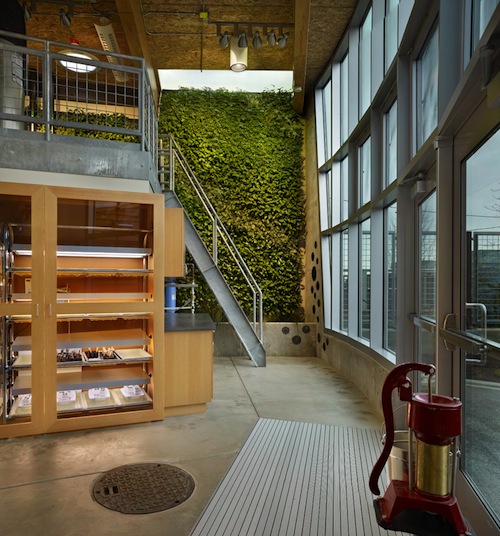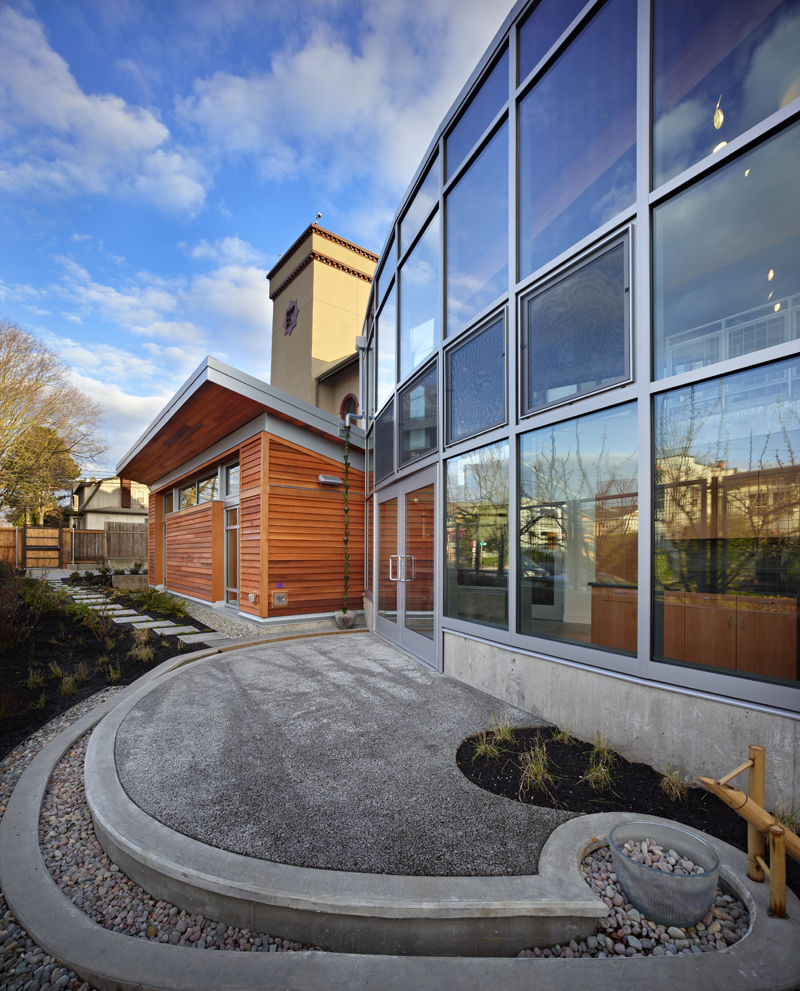SEATTLE, WASH.—April 15, 2013— Bertschi School, an independent elementary school in the Capitol Hill neighborhood of Seattle, Wash., is now home to the first Living Building on the West Coast and the world’s fourth fully-certified Living Building. Completed in February 2011, Bertschi’s Living Building Science Wing is a 3,380 square foot interactive learning environment for students ages 5-11. It is the first built project to meet the standards of version 2.0 of the Living Building ChallengeSM, a green building certification program which integrates urban agriculture, social justice and universal access issues, and the use of healthy building materials.
A program of the International Living Future Institute, the Living Building Challenge(LBC) is widely considered the world’s most rigorous building performance standard. A Living Building generates all of its own energy through clean, renewable resources; captures and treats its own water; incorporates only non-toxic, appropriately sourced materials; and operates efficiently and for maximum beauty. A building must perform as designed for one full year of occupancy and pass a third-party audit before receiving certification as “Living.”
Conceptualized with significant teacher and student input, the Science Wing serves as the ultimate tool for teaching science and sustainability. Students participate in real-time monitoring of the building’s energy and water use to understand sustainable practices and witness the impact of their daily choices on the building’s performance.
"At Bertschi School, we are committed to educating children to become thoughtful stewards of their local and global communities,” said Brigitte Bertschi, Head of Bertschi School. “We are not simply teaching about how to responsibly manage resources. The Science Wing allows students to put our curriculum to authentic use. I am proud that our children are empowered to make a difference at a very young age — even if it is a small one."
Bertschi School’s Science Wing sits on an urban site with an ethnobotanical garden that serves as an outdoor classroom. With its indigenous northwest plants, the garden enables students to learn about native culture and history, as well as use plant material in their art classes, such as berries for paint dyes and grasses used to fashion paint brushes. Food produced in this garden — and in the neighboring vegetable garden on-site — helps educate students about the values of organic farming and growing food.
The building’s sustainable features are visible and functional to foster dynamic learning opportunities. It is net-zero energy and water; a 20 kilowatt photovoltaic system provides all of the electricity, and cisterns collect rainwater that is used for irrigation and flushing the composting toilet. Excess captured water is absorbed by the on-site rain garden. Other water-saving features include a green roof and an interior living wall of tropical plants, which treats all of the building’s grey water.
The design of the Science Wing derived from a partnership between Bertschi School and the Restorative Design Collective, a multi-disciplinary team led by KMD Architects and comprised of leading Pacific Northwest green building professionals. The Collective contributed their design services pro-bono, with donations amounting to more than $500,000 in professional time and building materials.
“The challenges in creating truly net-zero energy and water buildings help all of us understand the integrative and continual efforts that are necessary to achieve the high-performance buildings that our changing planet requires,” said Stacy Smedley of KMD Architects, co-founder of the Restorative Design Collective.
In order to meet LBC standards, Skanska USA’s green building team navigated the strict material requirements to source building products that did not contain any of the materials or chemicals on the LBC Red List. One of the greatest challenges in this effort was finding local manufacturers and vendors who were fully transparent about the chemical makeup of their products. The use of healthy materials promotes better indoor air quality, as well as furthers transparency in the building materials industry.
“The Living Building Challenge is creating a major shift in the built environment — just as LEED did 10 years ago,” said Chris Toher, executive vice president and general manager at Skanska USA Building. “Thanks to the Restorative Design Collective, the Bertschi Living Building Science Wing is a model for sustainability in construction, and has challenged our industry to push for more net-zero buildings in our region and beyond.”
"The Bertschi School Science Wing has met the highest standard for sustainable performance, and is a powerful model for school additions all over the globe,” said Jason F. McLennan, CEO of the International Living Future Institute. “The International Living Future Institute is extremely proud of the huge accomplishments of this wonderful academic project."
Bertschi School is located at 2227 10th Ave. East in Seattle. Tours of the Living Science Building will be available to attendees of this year’s Living Future unConference, the International Living Future Institute’s 7th annual green building summit taking place May 15-17 at the Westin Seattle. Additional tours will be offered by the school throughout the year. More information is available in the International Living Future Institute’s Living Building case study.
About Bertschi School
An independent elementary school known for its integrated, innovative program, Bertschi School has a strong commitment to sustainability and incorporates this focus into both its curriculum and operations. In 2007, the school completed construction on its main building, The Bertschi Center, which is the first LEED Gold certified elementary classroom building in Washington State. www.bertschi.org
About the Restorative Design Collective
The Restorative Design Collective was founded in 2009 by Stacy Smedley and Chris Hellstern of KMD Architects. The Collective recognizes and endeavors to further the Living Building Challenge, which plays an essential role in raising green building standards, meeting the 2030 Challenge and creating net-zero buildings. Members of the Collective and its collaborators include: GGLO, landscape architect; 2020 Engineering, civil engineer; Back to Nature Design LLC, food systems consultant; GeoEngineers, geotechnical engineer; Morrison Hershfield, envelope consultant; O’Brien and Company, sustainable design consultant; Quantum Consulting Engineers, structural engineer; Rushing, mechanical-electrical-plumbing engineer; Skanska USA Building, general contractor; and Parsons Public Relations, as well as the City of Seattle and King County. KMD’s strong commitment to research-based design and collaboration fostered the opportunity to bring together a group of Seattle-area design professionals who share the desire to push themselves and their firms to the forefront of the sustainable building movement and create a built case study of a Living Building.
About the International Living Future InstituteSM and the Living Building ChallengeSM
The International Living Future Institute is an environmental NGO committed to catalyzing the transformation toward communities that are socially just, culturally rich and ecologically restorative. The Institute is premised on the belief that providing a compelling vision for the future is a fundamental requirement for reconciling humanity’s relationship with the natural world. The Institute operates the Living Building Challenge, the built environment’s most rigorous performance standard, and Declare, an ingredients label for building materials. It also houses the Cascadia Green Building Council and Ecotone Publishing.
The Living Building Challenge, the Institute’s best-known program, calls for the creation of a built environment that is as elegant and efficient as nature’s architecture. To be certified under the Challenge, a project must demonstrate that it has achieved 20 rigorous imperatives including net-zero energy, waste and water and alignment with a Red List of worst-in-class materials. The Challenge is the 2012 winner of the Buckminster Fuller Prize.
Related Stories
Codes and Standards | Apr 12, 2024
ICC eliminates building electrification provisions from 2024 update
The International Code Council stripped out provisions from the 2024 update to the International Energy Conservation Code (IECC) that would have included beefed up circuitry for hooking up electric appliances and car chargers.
Urban Planning | Apr 12, 2024
Popular Denver e-bike voucher program aids carbon reduction goals
Denver’s e-bike voucher program that helps citizens pay for e-bikes, a component of the city’s carbon reduction plan, has proven extremely popular with residents. Earlier this year, Denver’s effort to get residents to swap some motor vehicle trips for bike trips ran out of vouchers in less than 10 minutes after the program opened to online applications.
Laboratories | Apr 12, 2024
Life science construction completions will peak this year, then drop off substantially
There will be a record amount of construction completions in the U.S. life science market in 2024, followed by a dramatic drop in 2025, according to CBRE. In 2024, 21.3 million sf of life science space will be completed in the 13 largest U.S. markets. That’s up from 13.9 million sf last year and 5.6 million sf in 2022.
Multifamily Housing | Apr 12, 2024
Habitat starts leasing Cassidy on Canal, a new luxury rental high-rise in Chicago
New 33-story Class A rental tower, designed by SCB, will offer 343 rental units.
Student Housing | Apr 12, 2024
Construction begins on Auburn University’s new first-year residence hall
The new first-year residence hall along Auburn University's Haley Concourse.
K-12 Schools | Apr 11, 2024
Eric Dinges named CEO of PBK
Eric Dinges named CEO of PBK Architects, Houston.
Construction Costs | Apr 11, 2024
Construction materials prices increase 0.4% in March 2024
Construction input prices increased 0.4% in March compared to the previous month, according to an Associated Builders and Contractors analysis of the U.S. Bureau of Labor Statistics’ Producer Price Index data released today. Nonresidential construction input prices also increased 0.4% for the month.
Healthcare Facilities | Apr 11, 2024
The just cause in behavioral health design: Make it right
NAC Architecture shares strategies for approaching behavioral health design collaboratively and thoughtfully, rather than simply applying a set of blanket rules.
K-12 Schools | Apr 10, 2024
A San Antonio school will provide early childhood education to a traditionally under-resourced region
In San Antonio, Pre-K 4 SA, which provides preschool for 3- and 4-year-olds, and HOLT Group, which owns industrial and other companies, recently broke ground on an early childhood education: the South Education Center.
University Buildings | Apr 10, 2024
Columbia University to begin construction on New York City’s first all-electric academic research building
Columbia University will soon begin construction on New York City’s first all-electric academic research building. Designed by Kohn Pedersen Fox (KPF), the 80,700-sf building for the university’s Vagelos College of Physicians and Surgeons will provide eight floors of biomedical research and lab facilities as well as symposium and community engagement spaces.



















